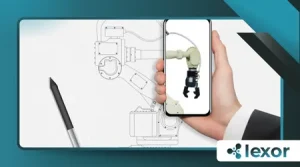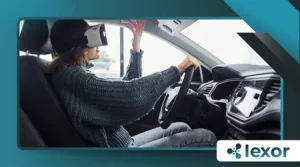Virtual Reality in Automotive Design and Engineering

The automotive industry is undergoing a seismic shift, and at the heart of this transformation lies Virtual Reality in Automotive Design and Engineering.
No longer a futuristic concept, VR has become an indispensable tool, reshaping how vehicles are designed, engineered, and even marketed.
From reducing prototyping costs to enabling global collaboration, VR is eliminating traditional barriers. But what does this mean for automakers, engineers, and consumers?
How is this technology being applied today, and where is it headed?
This deep dive explores VR’s impact on automotive innovation, backed by real-world applications, hard data, and expert insights. Whether you’re an industry professional or a tech enthusiast, understanding this evolution is crucial.
Breaking the Mold: VR’s Role in Modern Car Design
The days of relying solely on clay models and physical prototypes are fading fast.
Today, automotive designers use Virtual Reality in Automotive Design and Engineering to create, modify, and refine vehicles in a fully immersive digital space.
Companies like Porsche and Mercedes-Benz have integrated VR into their design studios, allowing engineers to manipulate 3D models in real time.
A designer can adjust the slope of a windshield, test aerodynamics, or evaluate interior ergonomics—all without touching a physical prototype.
This shift isn’t just about convenience; it’s about precision. In VR, every millimeter matters. Engineers can simulate how light reflects off a car’s surface at different times of day, ensuring aesthetic perfection before production begins.
One standout example is BMW’s use of VR to refine its i-series electric vehicles. By testing virtual prototypes, the company reduced design iterations by 30%, accelerating time-to-market.
++Understanding Smart Glasses: How They Work
But VR’s influence goes beyond aesthetics. It’s also transforming functional design. Engineers can now simulate how different materials behave under stress, optimizing safety without costly crash tests.
The result? Faster innovation, lower costs, and vehicles that are both beautiful and functional from the first sketch.
Engineering Without Limits: Simulation and Testing in VR
Physical prototypes are expensive and time-consuming. Virtual Reality in Automotive Design and Engineering eliminates these constraints by allowing engineers to test vehicles in a risk-free digital environment.
Ford’s Immersive Vehicle Environment (FIVE) lab is a prime example. Engineers use VR to simulate assembly line processes, identifying potential bottlenecks before production begins.
This proactive approach has cut manufacturing errors by up to 25%.
Crash testing, once a destructive and costly necessity, can now be performed virtually. Companies like Volvo use VR to simulate thousands of crash scenarios, fine-tuning safety features without wrecking a single car.
++Virtual Reality in Tourism: Exploring the World from Home
Even aerodynamics testing, traditionally reliant on wind tunnels, is moving into VR. By digitally modeling airflow, automakers can optimize fuel efficiency and performance before a car ever hits the road.
A McKinsey report confirms that VR reduces prototyping costs by up to 40%. For an industry where a single prototype can cost millions, this isn’t just an improvement—it’s a revolution.
The Human Factor: Global Collaboration in Real Time

Designing a car is a collaborative effort, often involving teams across continents. Virtual Reality in Automotive Design and Engineering bridges these distances, enabling real-time collaboration in a shared virtual space.
Audi’s VR collaboration platform allows engineers in Germany to work alongside designers in California as if they were in the same room. Changes made by one team are instantly visible to all, drastically reducing approval times.
Read more: The Role of Virtual Reality in Disaster Preparedness and Training
This isn’t just about convenience—it’s about creativity. When designers and engineers interact in VR, they can brainstorm, experiment, and iterate faster than ever before.
Toyota has taken this a step further by using VR for virtual design reviews. Executives can “walk around” a digital car, examining every detail before giving final approval.
The result? Faster decision-making, fewer misunderstandings, and a more streamlined production process.
Tesla’s Virtual Showroom Revolution
Tesla has always been a disruptor, and its use of Virtual Reality in Automotive Design and Engineering is no exception.
The company’s VR showrooms allow customers to explore every detail of a Cybertruck or Model S before it’s even built.
No dealership visits, no waiting for test drives—just an immersive, interactive experience. Customers can change colors, inspect interiors, and even simulate driving conditions, all from their homes.
This approach isn’t just innovative; it’s reshaping customer expectations. Why visit a showroom when you can experience a car in VR?
The Road Ahead: Challenges and Opportunities
Despite its advantages, VR adoption in the automotive industry isn’t without hurdles. High initial costs and technical complexity remain barriers for smaller manufacturers.
However, as VR hardware becomes more affordable and software more intuitive, even indie carmakers will likely embrace the technology.
Could VR eventually replace physical testing entirely? Probably not—but it’s certainly shifting the balance, making innovation faster and more accessible.
The Sustainability Edge: How VR is Making Automotive Design Greener
One often overlooked benefit of Virtual Reality in Automotive Design and Engineering is its environmental impact. Traditional prototyping consumes massive amounts of materials – clay, metals, plastics – much of which ends up as waste after testing. VR eliminates this physical waste entirely.
Jaguar Land Rover reported reducing its prototyping material waste by 75% after implementing VR design systems.
When you consider that a single clay model can weigh over 2,000kg, the cumulative environmental savings across the industry become staggering.
This positions VR not just as a technological advancement, but as a crucial sustainability tool in an increasingly eco-conscious automotive market.
Training the Next Generation: VR in Automotive Education
The influence of Virtual Reality in Automotive Design and Engineering extends beyond corporate R&D labs.
Technical schools and universities are now incorporating VR into their automotive engineering curricula.
Students can practice complex assembly procedures or experiment with aerodynamic designs in virtual environments before ever touching real components.
The University of Michigan’s automotive engineering program uses VR stations where students can disassemble and reassemble virtual engines with perfect accuracy.
This hands-on virtual training produces better-prepared graduates while reducing the costs and risks associated with training on physical vehicles.
For further reading, check out BMW’s VR Design Process and McKinsey’s Automotive Tech Report.
As VR systems become more affordable, expect to see this educational approach become standard at technical institutions worldwide.
Final Thoughts: The Unstoppable Rise of VR in Automotive Innovation
Virtual Reality in Automotive Design and Engineering isn’t just a tool—it’s a game-changer. From design to production to customer engagement, VR is rewriting the rules of the automotive industry.
The question isn’t whether your favorite car brand uses VR, but how creatively they’re pushing its limits.
Frequently Asked Questions
Q: How does VR reduce costs in automotive design?
A: By replacing expensive physical prototypes with digital simulations, automakers save millions in materials, labor, and testing.
Q: Can VR completely replace physical crash tests?
A: Not yet—while VR simulations are highly accurate, regulatory agencies still require real-world crash tests for certification.
Q: Which car brands are leading in VR adoption?
A: BMW, Ford, Audi, and Tesla are among the most advanced in integrating VR into their design and engineering processes.
Q: Is VR used in car manufacturing beyond design?
A: Yes—VR assists in assembly line optimization, worker training, and even virtual factory planning.
